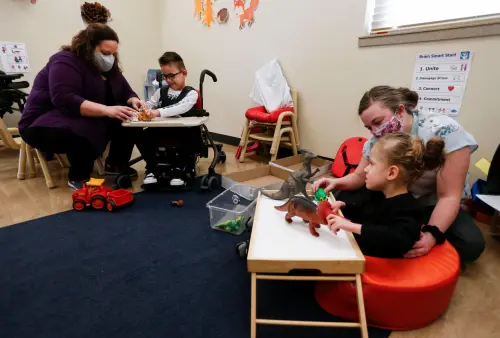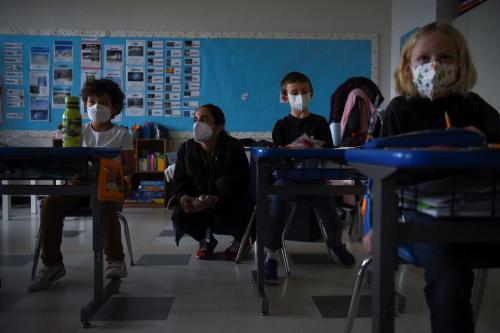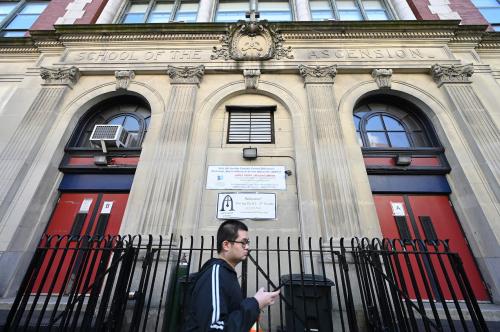This article was first published in The74 on January 30, 2024.
In 1983, a special commission organized by the U.S. Department of Education released A Nation at Risk, an unapologetic critique of America’s public schools. Its publication prompted both a firestorm of public response and a seismic shift of policy and practice reforms at every level of the education system, permanently altering the policy landscape that has shaped today’s public schools.
The report directed many pointed barbs at the teacher workforce and those tasked with preparing them. It concluded that both the quality of current teachers and the quantity of available talent to fill teaching roles in schools were sorely deficient; both dimensions needed immediate intervention to achieve educational excellence. What the report failed to do, however, was reconcile the inherent tensions in simultaneously pursuing both higher quality and quantity or offer a strategy to systematically develop the teacher workforce that was desired.
Consequently, as A Nation at Risk unleashed a wave of education reform, the initiatives focused on teachers were both expansive and incoherent. In my essay, “Strategically prioritizing teacher quality and quantity can reinvigorate the teacher pipeline,” recently published in the Hoover Institution’s A Nation at Risk +40 series (edited by Stephen L. Bowen and Margaret E. Raymond), I recount the divergent approaches to reforming the teacher workforce that developed over time.
This post highlights some of the lessons learned from looking back at the 40 years of reform and research on the teacher pipeline since the report’s publication.
Teachers: Part of both the problem and the solution
In the late 1970s and early 1980s leading up to the report’s publication, the public seemed to be losing confidence in the nation’s public schools. Student achievement was stagnating, enrollments were falling, and desegregation efforts were widely perceived as increasing racial tensions but not school outcomes.
The teacher workforce was also viewed as a depreciating asset. The professional workforce was opening for educated young women, and fewer college students chose to pursue teaching as a career. The profession was also increasingly unionizing starting in the late 1960s, and public sentiment turned decidedly anti-union under the Reagan administration, with unions often perceived as stymying public schools’ ability to serve students.
It was into this downtrodden atmosphere that A Nation at Risk’s scathing critiques were published. Yet instead of arguing for divestment from public schools, the report offered a laundry list of recommendations to promote comprehensive reform. Policy recommendations regarding teachers and the pipeline leading to the classroom featured prominently in this list, including compensation reform, student grants or loans for those who commit to becoming teachers, and alternative certification.
The report’s authors clearly felt that the teacher workforce had problems with both the quality of the workforce and the quantity of people signing up for the profession, and both needed to be remediated. However, the report failed to acknowledge that quality and quantity are inherently in conflict—for example, as far as the teacher pipeline is concerned, prioritizing quality will limit the quantity of people who can meet the higher expectations.
Improving the teacher workforce on either dimension would have been challenge enough, but to address both teacher quality and quantity simultaneously would be a Herculean feat.
Two approaches to reform teaching, frequently in conflict
Some teacher policy actions started immediately in the wake of the report—for example, four states had adopted alternative certification pathways by the following year. Other initiatives incubated for a bit before reaching maturation, including the establishment of the National Board of Professional Teaching Standards (NBPTS) in 1987.
Looking back at the various approaches to shoring up the teacher pipeline, I categorize these policy actions into two types. Actions that seek to shore up weak points in the teacher workforce and recruit more into the profession I call “outside-in” reforms, as they see the primary challenge of teaching as a failure to attract and retain the best talent (think of alternative certification or loan forgiveness policies). Another approach sees the failure to support and develop talent within the workforce as the primary challenge. I call these “inside-out” initiatives (think of NBPTS or career ladders).
These two approaches are not inherently in conflict, but they take different stances on the relative importance of teacher quality versus quantity. The “outside-in” approaches lean heavily on teacher quantity first (through recruiting to high-need settings, say) and then assume policies will follow that enable school systems to be more selective to ensure teacher quality. The “inside-out” approach reverses that prioritization, focusing on developing quality within the workforce first (through demonstrating mastery through NBPTS certification, for example) and assuming that elevated role will attract new supplies of teacher candidates.
With limitations on both funding and public attention, these two approaches often find themselves in conflict within the education policy space. Moreover, these diverging approaches have attracted different sets of advocates and public champions over time (for example, think of philanthropic megadonors often representing the “outside-in” approach and teacher unions as representing the “inside-out” approach). These groups frequently engage in conflict over teachers’ role (or blame) for past failures and offer contrasting views towards school improvement. Conflicts like these are at the heart of why teaching has earned the ignominious label of “the most embattled profession.”
Strategically deploying different strategies, based on school context
Despite these conflicts, both policy approaches offer good ideas that have been borne out in the evidence, though they also come with limitations. And neither set offers enough to ensure a sufficient supply of effective teachers accessible for all students, a key objective. If only we could deploy these policies in complementary ways, then we can make headway on some of the real staffing challenges facing schools.
What this looks like in practice is that we develop a systematic plan about workforce management that is sensitive to workforce needs on the ground. The most important context here—the one conspicuously omitted from A Nation at Risk—is school settings that serve high-need student populations. We must recognize that these schools have a unique difficulty attracting and retaining quality teachers. Consequently, these schools spend disproportionate amounts of money and time recruiting, interviewing, and onboarding new teachers. Even if they could invest in building teacher quality, the high levels of turnover lower the expected return on that investment. In other words, these schools have a problem with teacher quantity first.
I propose that policymakers and school leaders prioritize efforts that build and sustain teacher quantity in these settings; in other words, the “outside-in” options are those most readily applicable. For example, monetary bonuses for teachers or generous service scholarships conditioned on working in high-need settings would be an excellent way to shore up the workforce. This does not mean that we ignore quality in these schools entirely, but we should only look to building quality once policies prioritizing a robust supply of qualified teachers are firmly in place, avoiding the unfortunate (but too common) scenario in which disadvantaged schools are seen as mere training grounds for novices before moving to greener pastures. Thus, the quality-developing “inside-out” reforms come second.
Outside of these high-need settings, where teacher supply is not nearly such a pressing need, these schools should emphasize building teacher quality first. Thus, the “inside-out” options come to the foreground. Further, as they develop and sustain these approaches, they can in turn offer a supply of high-quality teachers to support higher-need settings.
The state of the teacher pipeline continues to challenge schools
The state of public schools now is, on the surface, very different from that in 1983. We have just recently witnessed schools shutting down for months on end to limit the spread of COVID-19. Schools have also become new battlegrounds in culture wars.
These developments have impacted the teacher workforce. First, teachers became frontline workers aiding children’s learning recovery, and signs point to increased burnout and elevated turnover in the wake of the pandemic. Second, the culture wars appear to have had a chilling effect on teachers. These challenges are layered on top of a teacher pipeline that was already weakened before the pandemic hit, prompting some experts to warn of a “perfect storm” forming in the teacher labor market.
The pipeline into teaching is objectively worse now than at any other point in recent memory, with nearly 162,000 completers of teacher training programs in 2020-21, a decline of over 40% from the 1970 peak (284,000 completers). These teacher graduates are now serving a student body that is more than 10% larger today than it was in 1970. The growing cost of college is also a widely perceived barrier for entry into the profession, especially for people of color who have fewer financial resources and are more burdened by debts to get through school. Yet, enrollment in colleges are on the decline, offering little hope for a resurgent teacher pipeline.
Under the surface, though, I also observe parallels between then and now. In 1983, like today, student achievement was tapering off after a period of high growth, and there was growing dissatisfaction with the state of public schools. Also, student enrollments were dropping, as some families began opting for non-public school options. It was clear then, as it seems now, that our public schools are far from returning to that level of performance in our recent past.
Another fascinating parallel comes from a 2022 study by Kraft and Lyon. Looking at historical trends in teacher prestige, interest in the profession, teacher preparation, and teacher satisfaction, the authors conclude that the teacher workforce is now near or at historic lows. In fact, the last time we were in this position was in the early 1980s, right before A Nation at Risk. Afterwards, there was a quick upsurge in public support for and interest in the teaching profession, though the authors could not pinpoint exactly what the catalyst was back then. Perhaps part of this turnaround was new messaging about the nobility of the teaching profession (championed by those reforming from the “inside out”). Perhaps part of the new interest in teaching was due to easier access into the profession and visible pay reform efforts (thanks to the “outside-in” reformers).
Regardless of the source, what it suggests to me is that a much-improved prognosis for the teacher workforce and pipeline may not be far around the corner. We don’t need to think of new solutions. We just need to deploy the ones we have with more strategy and purpose.
The Brookings Institution is committed to quality, independence, and impact.
We are supported by a diverse array of funders. In line with our values and policies, each Brookings publication represents the sole views of its author(s).








Commentary
‘A Nation at Risk’ offers key lessons for reinvigorating America’s teacher workforce
February 1, 2024